
Oakhouse: Social Residence Higashi Koganei
“Oakhouse Social Residence Koganei” en el suburbio de Koganei de Tokio es una casa compartida que ofrece residencia a largo plazo para residentes japoneses e internacionales.

El Museo Ghibli está ubicado en Mitaka, Tokio y ofrece a los fanáticos del famoso estudio de anime una visión del mundo fantástico del director Hayao Miyazaki, quien ayudó a crearlo.
Admission to the Ghibli Museum is by advance reservation only.
El museo abrió el 1 de Octubre de 2001 y está ubicado en el Parque Inokashira. Mientras que un nivel está dedicado a los procesos de producción de las películas de Ghibli y muestra el desarrollo desde el borrador hasta la animación terminada, el segundo piso alberga exposiciones temporales sobre el tema de Ghibli y las diversas producciones. También puedes encontrar réplicas de ciertos lugares y personajes de las películas, como el autobús gato de “Mi vecino Totoro” o el robot a tamaño real de “El castillo en el cielo”. También hay una cafetería y una tienda de recuerdos.
Las entradas solo se pueden comprar con antelación, no hay taquilla. Fuera de Japón, los boletos se pueden comprar en varios proveedores en línea, mientras que dentro de Japón, puede comprarlos en máquinas expendedoras en tiendas de conveniencia. Los boletos se pueden comprar con un mes de anticipación como mínimo y son válidos para un día y un período de tiempo específico.
Take the JR Chuo Line to Mitaka Station. From the south exit of JR Mitaka Station, it's a 15-minute walk to the museum.
A community bus runs from JR Mitaka Station to the museum. The loop bus service runs approximately every 10 minutes. Bus tickets are on sale at the vending machine by Bus Stop No. 9.

“Oakhouse Social Residence Koganei” en el suburbio de Koganei de Tokio es una casa compartida que ofrece residencia a largo plazo para residentes japoneses e internacionales.

With Koenji being a "creative town" it's no surprise that the BnA Hotel opened there in 2016 and has had, subsequently, an incredible impact on the local community. BnA (Bed and Art) has other spaces dotted about Tokyo and Kyoto, but the Koenji edition is possibly more immersive as the concept is "stay in an artwork." In collaboration with local artists, the BnA has created an impressive multi-storey art experiment for art lovers and creatives with a desire to inhabit art. The first floor acts as a front desk and bar which comes alive at night with events and selected DJs. It also hosts Masu Masu onigiri cafe with artists being asked to come and exchange artwork with each other in a gesture which reflects the true spirit of Koenji. With two "living art" twin rooms taking up the second and third floors designed by a seasonal rotation of local artists, guests can engage with and inhabit their art rooms. BnA Koenji also plays host to a rooftop lounge and a basement space which is used for artists residencies where their work is shown to the public and a DJ booth and streaming equipment for live performances. With live painting events and an eclectic variety of regular events, the BnA Hotel becomes, itself, a living canvas. The BnA believes that it's a machigata hotel, meaning that guests should (and are encouraged) to interact with Koenji. Use the public sentos, eat in the local restaurants that surround the hotel and buy locally from the multitude of shops, market stalls, bars and cafes which make-up the fabric of Koenji. Feted by international press such as The Guardian, BnA acts as a creative network with the concept of serendipity being discussed as the bar becomes an ad hoc meeting place where collaborations and friendships between artists and locals are born. The BnA was also instrumental in a street art festival named MCP (Mural City Project) which was supported by Suginami Ward. MCP was incredibly ambitious and truly communal with the desire to transform and coalesce the community through the creation of public murals. The BnA, Koenji and Suginami spearheaded a public art movement which should be commended and replicated throughout Tokyo.

Harmonica Alley se encuentra en la zona de moda de Kichijoji y es una sección de bares locales de izakaya que están a solo unos minutos a pie de la estación de tren. Los callejones de Harmonica Allee son estrechos y al mismo tiempo están llenos de vida, los cuales están abiertos durante el día, así como izakayas y pubs que se pueden visitar hasta altas horas de la noche. Desde la década de 1990, Harmonica Alley ha sido particularmente popular entre los lugareños por sus bares de pie con bocadillos económicos al final de la noche. El área recibió su nombre por la forma en que esta apretada maraña de restaurantes, tiendas y bares se asemeja a una armónica. Estos bares pueden llenarse rápidamente, ¡pero definitivamente nunca se vuelve incómodo!
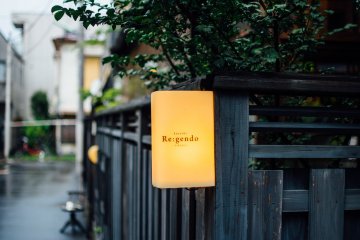
"Re: gendo es un café, tienda de ropa y artesanías que se encuentra en las pintorescas calles de Nishi-Ogikubo y a solo unos minutos de la estación. Este café representa todo lo relacionado con la prefectura de Shimane capturando la esencia de su historia, cultura y belleza que ayuda a inspirar todo lo que se ofrece aquí. Ubicado en una espectacular estructura de madera la cual se dice que tiene alrededor de 90 años, Re: gendo es un homenaje a Shimane, el personal y los propietarios se preocupan por mostrar la historia y cultural de su amada tierra natal. Es un espacio peculiar, distribuido en dos plantas. Actúa como un restaurante próspero, una tienda de ropa, una tienda de artesanías y un taller que se centra en la enseñanza de la artesanía y las habilidades culinarias. El café reconoce los diferentes matices involucrados en los productos de Shimane como el arroz, que se utiliza para sus menús de almuerzo de temporada extremadamente populares; musubi zen y nigiri zen. Musubi zen consiste en un plato fuerte de pescado o carne, mientras que nigiri muestra sushi nigiri de verduras. Ambos platos vienen con acompañamientos que incluyen verduras, encurtidos y sopa de miso. Los ingredientes de Re: gendo se obtienen localmente en Toyo o en Shimane. El café también ofrece una excelente colección de dulces (la gente de Shimane es particularmente aficionada al wagashi o la repostería tradicional japonesa). La sección de ropa y manualidades, ubicada en el primer piso adyacente al café, incluye una variedad de artesanías de Shimane y una línea de moda curada que utiliza un tipo de tinte no tóxico de Shimane siendo mucho más seguro para mujeres embarazadas o clientes con alergias. El segundo piso alberga talleres regulares sobre artesanía y cocina local. Visitantes de todo el mundo vienen y participan en estos talleres y aprenden las complejidades involucradas en la abundancia de especialidades de Shimane. Re: gendo actúa entonces como un centro local y una atracción popular para muchos de los trasplantes de Shimane de Tokio. Refinado, culto, respetuoso de las tradiciones ancestrales y amigable debe considerarse una parada imprescindible en cualquier visita a Nishi-Ogikubo.
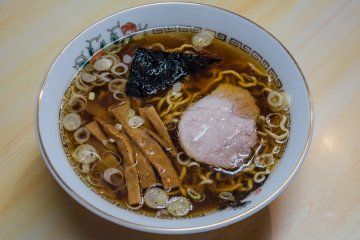
Ramen has become a global cuisine over the past decade with ramen-ya popping up in cities all over the globe. Millions of visitors, however, flock to Japan every year to experience the real deal. Harukiya, located a few minutes from JR Ogikubo Station, is a Tokyo institution. Established in 1949 it is the originator of Tokyo-style ramen which uses niboshi (dried baby sardines) in its broth and has been serving up first-class soy sauce which hasn’t changed for more than 70 years and has, rightly, earned it a legion of devotees. Although Harukiya has a sister branch in nearby Kichijoji, the Ogikubo store is the original and takes great pride in creating its authentic Tokyo-style chuka soba as well as chashumen and wontonmen. The aroma from the ramen floats into the outside streets having a visible effect on the patrons who queue daily to get their hands on Harukiya’s mouth-watering ramen. Popular with Ogikubo residents and foreign ramen aficionados, Harukiya has a small, curated menu with toppings, cold noodles and a few side dishes which accompany the ramen. Harukiya has led the Tokyo ramen industry for generations and there’s a reason for this. The aromatic soy sauce ramen and hand made noodles which are freshly kneaded every morning have inspired ramen lovers and ramen chefs the world over and will continue to do so for many more years to come.
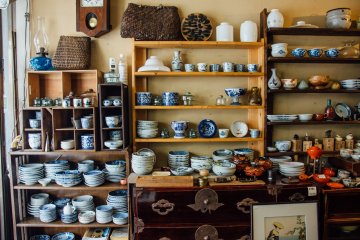
Kidoairaku forma parte importante de la comunidad de antigüedades de Nishi-Ogikubo y juega un rol reflejando la riqueza de las antigüedades de la prefectura de Yamagata,de donde es originario el propietario, Takashi Watanabe. Situado a pocos minutos de la estación JR Nishi-Ogikubo en la línea Chuo, Kidoairaku es un cofre de tesoros lleno antigüedades y una encantadora y acogedora tienda. La tienda es pequeña pero está llena de interesantes variedad de antigüedades de períodos históricos como Edo, Meiji y Taisho. Kidoairaku no se especializa particularmente en un particular tipo de antigüedades sino que refleja los intereses y pasiones del propietario y los clientes leales que acuden allí a diario. Popular entre los visitantes extranjeros es la variedad de hermosas imágenes “ukiyo-e”. La tienda también alberga una cuidada selección de porcelana, cerámica y muebles como cajoneras diseñadas con ilustraciones de sakura (flores de cerezo). Kidoairaku es un encantador y acogedor lugar que actúa como una puerta informativa y atractiva a la próspera y bulliciosa escena de antigüedades de Nishi-Ogikubo.
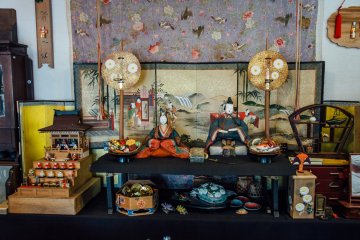
Situated in Tokyo’s Nishi-Ogikubo area, which acts as the capital’s antiques hub, Tori Tori is a quirky and relaxed antiques store located a few minutes walk from JR Nishi-Ogikubo Station. Adjacent to another excellent antiques store, Kidoairaku, Tori Tori is renowned for dealing in Japanese dolls. Vibrant and full of life Tori Tori specializes, mostly, in hinakazari or dolls used for hinamatsuri (event that prays for girls' healthy growth and happiness). The incredible display of vintage dolls from various historical periods is spellbinding and a reminder of Japan’s profound connection with history and antiquities. The store also sells other, quirky dolls in a variety of styles as well as a fine collection of textiles, furniture, miniatures, toys and hand-crafted sensu (Japanese hand held fans) which are popular with many visitors looking for a taste of genuine Japanese culture. Tori Tori, then, is a window into Japan’s rush, cultural past and is a flourishing member of Nishi-Ogikubo’s antiques scene.
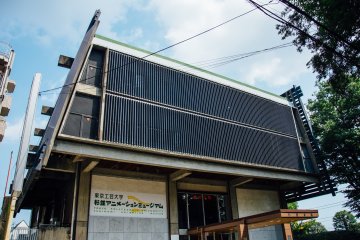
Tokyo Polytechnic University Suginami Animation Museum is situated in Ogikubo, known as being home to over 130 animation companies. Part of Suginami Kaikan Hall, the museum spans three floors and is packed with interactive exhibits which are perfect for kids and adults alike. The museum also explains the history of animation in Japan and the massive cultural influence it has on the country and, of course, globally. Tokyo Polytechnic University Suginami Animation Museum (which is free to enter) is extremely popular with foreign anime lovers and has some really quirky exhibits such as the animation timeline wall that showcases over 100 years of animation history in Japan. Other highlights include digital workshops for drawing and coloring animation in addition to the voice-over booth for famous animation “Astro Boy.” Visitors can hear their own voice while watching a short clip from the hugely influential animation. There is also a kids drawing and sketching area as well as computers available for games and interactive activities. The third floor library is a welcome oasis of calm and visitors can leisurely sit and read through various books about animation or watch a selection of DVDs. There is also a small cinema which shows various animations that can be enjoyed on the large screen. Although it’s a space dedicated to Japanese pop culture, the museum has made a huge effort to cater for foreign guests and has audio guides in a variety of languages as well as exhibit explanations in other languages including English. Suginami Animation Museum is a really entertaining experience and even non-anime geeks will enjoy the eclectic array of exhibits and activities. Perfect for families or anyone with a passing interest in pop culture and Japan.